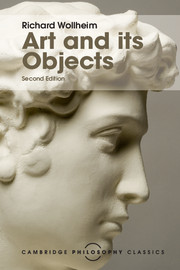Preface to this edition
Published online by Cambridge University Press: 05 November 2015
Summary
Art and its Objects ends abruptly with the claim – surprising in an age obsessed with distinguishing between facts and values and with worrying about the logical status of value judgments – that, deliberately, next to nothing has been said in this book about the evaluation of art. Instead, Wollheim's central aim is to understand what we are doing when we are either making or attending to art – an enterprise, as it were, of descriptive phenomenology. Two related, central ideas running through his account are that we demand a certain sort of experience from the things that we undertake to engage with as art, and that artmakers are typically responsive to this demand.
Both the nature of this demand and the available modes of response to it then emerge as far more complex and interesting than unidimensional accounts of art as a matter of pleasure or expression or form alone suppose. For one thing, works of art fall into types – poems, sculptures, operas, paintings, buildings, ballets, among others – not all of which require the work of art to be itself a physical object. More important, even when the work is a physical object, as in sculpture or painting, it has formal, expressive, and stylistic properties that are not reducible either to its physical features alone or to mere effects in the minds of its recipients. Hence Wollheim powerfully criticizes both sensuous-presentationalist-formalist theories of art and phenomenalist-idealist theories of art for focusing on only one aspect of works that typically and centrally involve the working of materials, against a background of practices and traditions, for the sake of complex, interrelated effects. What Wollheim calls ‘the working of the medium’ (p. 36) – pictorial, verbal, acoustic, and so on – matters.
There is no way apart from historically and critically informed experience of art to specify the materials and modes of working them that yield successful works. Both ‘the artistic impulse’ (p. 93) and the demands we make on art are, while rooted in biological facts about human beings, nonetheless not reducible to them.
- Type
- Chapter
- Information
- Art and its Objects , pp. ix - xPublisher: Cambridge University PressPrint publication year: 2015



